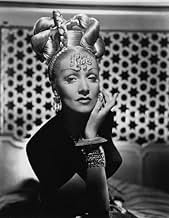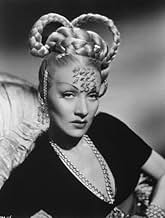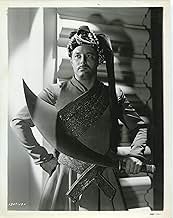PUNTUACIÓN EN IMDb
6,0/10
1,4 mil
TU PUNTUACIÓN
Añade un argumento en tu idiomaIn ancient Baghdad, Hafiz the King of Beggars dreams of untold riches and of marrying his daughter to a real prince.In ancient Baghdad, Hafiz the King of Beggars dreams of untold riches and of marrying his daughter to a real prince.In ancient Baghdad, Hafiz the King of Beggars dreams of untold riches and of marrying his daughter to a real prince.
- Dirección
- Guión
- Reparto principal
- Nominado para 4 premios Óscar
- 1 premio y 4 nominaciones en total
Eddie Abdo
- Aide to Mansur
- (sin acreditar)
- …
Jimmy Ames
- Major Domo
- (sin acreditar)
Morris Ankrum
- The Caliph's Messenger
- (sin acreditar)
Leslie Anthony
- Handmaiden
- (sin acreditar)
Lynn Arlen
- Handmaiden
- (sin acreditar)
Noble Blake
- Nubian Slave
- (sin acreditar)
Carla Boehm
- Handmaiden
- (sin acreditar)
Dick Botiller
- Aide to Mansur
- (sin acreditar)
Reseñas destacadas
Third movie version of popular story involving beggar/magician in Bagdad who impersonates a prince. Meanwhile, the beggar's daughter falls for a camel-boy who's really a prince in disguise! Somehow, Marlene Dietrich gets shoehorned in playing sheltered royalty who rebels by doing a hot dance routine which must've been pretty risqué for 1944 (she's slathered in gold paint). MGM adventure does a nice job rewriting the original play by Edward Knoblock, featuring a colorful production and welcome comedic elements. It's jaunty fun with a fairly fast pace, hindered only by Ronald Coleman's miscasting in the lead (and his surprising lack of chemistry opposite Dietrich). Nominated for four Oscars, including Charles Rosher for his cinematography. Remade as a musical in 1955. **1/2 from ****
More Arabian Nights stuff, this time emanating from the studio where the lion roared: according to the Internet Movie Database, there are twenty (count 'em) films that go by the name of KISMET and, although the Vincente Minnelli-Howard Keel musical version is the best-known of the lot, this earlier straight adaptation starring Ronald Colman and Marlene Dietrich is perhaps the best-regarded. For the record, I do have the former on VHS but won't have time to catch it just now and, of all the rest, I'm mostly interested in the 1930 German version (there was another one made in Hollywood the same year) which, like the film under review, was directed by William Dieterle! Speaking of which, I don't quite understand the reasoning of Warner Brothers (who have inherited DVD distribution rights to the MGM film library) behind recently releasing the 1955 version on this format on its own (so to speak, since it actually forms part of a Musical Collection) rather than coupled with the earlier version.
Aged 53, Ronald Colman still cuts a strikingly handsome figure (even when dressed as a beggar) and his silvery hairline is amusingly obscured by the most unseemly of turbans for all but one scene in the film's latter stages. Equally splendid-looking is his 43-year old German co-star who, in the film's most celebrated sequence that was, ironically, later cut for TV screenings because of its 'erotic' content(!), has her legs painted in gold for a veiled dance number before the court of evil Grand Vizier Edward Arnold and Colman (who dubs himself the King of Beggars by day but moonlights as a sovereign of a far-away land). Given the maturing age of the two leads, it's no wonder that two younger actors were recruited in the persons of James Craig (as the Caliph of Bagdad who likes to go incognito through the streets of his kingdom as a gardener's son) and the late Joy Page (Colman's secreted daughter); she had made a memorable screen debut in CASABLANCA (1942) and died earlier this year aged 83.
The cast is rounded up by Florence Bates (as Colman's nagging in-law), Harry Davenport (as Craig's wily adviser) and Hugh Herbert (as one of Colman's would-be comic-relief sidekicks). As was to be expected from Hollywood's premier studio, no expense was spared in bringing this opulent costumer to the screen including shooting in eye-filling Technicolor amidst impressively-constructed sets and this effort was rewarded by garnering the film four Academy Award nominations in that year's ceremony although, as had been the case (and would be again) with similar Oriental ventures, the nominees all went home empty-handed!
Aged 53, Ronald Colman still cuts a strikingly handsome figure (even when dressed as a beggar) and his silvery hairline is amusingly obscured by the most unseemly of turbans for all but one scene in the film's latter stages. Equally splendid-looking is his 43-year old German co-star who, in the film's most celebrated sequence that was, ironically, later cut for TV screenings because of its 'erotic' content(!), has her legs painted in gold for a veiled dance number before the court of evil Grand Vizier Edward Arnold and Colman (who dubs himself the King of Beggars by day but moonlights as a sovereign of a far-away land). Given the maturing age of the two leads, it's no wonder that two younger actors were recruited in the persons of James Craig (as the Caliph of Bagdad who likes to go incognito through the streets of his kingdom as a gardener's son) and the late Joy Page (Colman's secreted daughter); she had made a memorable screen debut in CASABLANCA (1942) and died earlier this year aged 83.
The cast is rounded up by Florence Bates (as Colman's nagging in-law), Harry Davenport (as Craig's wily adviser) and Hugh Herbert (as one of Colman's would-be comic-relief sidekicks). As was to be expected from Hollywood's premier studio, no expense was spared in bringing this opulent costumer to the screen including shooting in eye-filling Technicolor amidst impressively-constructed sets and this effort was rewarded by garnering the film four Academy Award nominations in that year's ceremony although, as had been the case (and would be again) with similar Oriental ventures, the nominees all went home empty-handed!
Often overshadowed these days by the musical version which came a decade later, this film by William Dieterle has the distinction of being one of the best examples of a 1940s Technicolor film there is. And with colour, no one shone out from the screen more than Marlene Dietrich. Here she is as Jamilla, garlanded in gold and looking positively luminous - her appearance in this movie alone would justify watching it.
Ronald Colman, that debonair English actor, plays the role of the beggar, Hafiz (which would be memorably played by Howard Keel in the musical). He's a little starchy and looks prematurely middle-aged, but he was always a very good actor, and here is no exception. James Craig is colourless as the Caliph but Edward Arnold and Hugh Herbert add humour as the Grand Vizier and Feisal.
The strength of this 'Kismet' though it definitely how it looks. It is how the films of the golden era were at their peak, and this version doesn't get shown on TV anywhere near enough.
Ronald Colman, that debonair English actor, plays the role of the beggar, Hafiz (which would be memorably played by Howard Keel in the musical). He's a little starchy and looks prematurely middle-aged, but he was always a very good actor, and here is no exception. James Craig is colourless as the Caliph but Edward Arnold and Hugh Herbert add humour as the Grand Vizier and Feisal.
The strength of this 'Kismet' though it definitely how it looks. It is how the films of the golden era were at their peak, and this version doesn't get shown on TV anywhere near enough.
10Molly-31
William Dieterle directing, music by Harold Arlen (there's even a tiny bit of the Witch's Guard music at one point!), opulent sets and gorgeous costumes, Ronald Colman -- what more could anyone ask?
The film was very carefully crafted. Even the bit players -- especially Henry Davenport and Florence Bates -- were perfect. From the beginning, you are immersed in a magical world, an Iraq that died long ago, the Islam of Arabian Nights and Haroun el-Raschid, a romantic culture with its own philosophies and mysteries. Karsha foretelling the future with a sand reading, the muezzin and his apprentice singing the call to prayer, or the public bathing place that the rascals hide in, give the film a sense not only of unity and atmosphere but of meticulous attention to detail.
Dietrich's character was not Greek but Macedonian (like Alexander the Great, another blonde). I could have stood for more authenticity in her dance (especially after the Kraft girls who preceded her -- their Deva Dasi style dance *was* pretty authentic) and that gold paint was a little much. Still, the idea was that Jamilla was wild, and did unconventional things.
I do see where it could have been better. Craig in particular sounds jarringly "modern". But you forget that after a while. Modern films don't present this kind of idealism. We have to have everything brought down to sordid reality. A thing like this is good for you after too much "realism" gunk.
The film was very carefully crafted. Even the bit players -- especially Henry Davenport and Florence Bates -- were perfect. From the beginning, you are immersed in a magical world, an Iraq that died long ago, the Islam of Arabian Nights and Haroun el-Raschid, a romantic culture with its own philosophies and mysteries. Karsha foretelling the future with a sand reading, the muezzin and his apprentice singing the call to prayer, or the public bathing place that the rascals hide in, give the film a sense not only of unity and atmosphere but of meticulous attention to detail.
Dietrich's character was not Greek but Macedonian (like Alexander the Great, another blonde). I could have stood for more authenticity in her dance (especially after the Kraft girls who preceded her -- their Deva Dasi style dance *was* pretty authentic) and that gold paint was a little much. Still, the idea was that Jamilla was wild, and did unconventional things.
I do see where it could have been better. Craig in particular sounds jarringly "modern". But you forget that after a while. Modern films don't present this kind of idealism. We have to have everything brought down to sordid reality. A thing like this is good for you after too much "realism" gunk.
I've always felt that the technicolor used in the 1940s constituted some of the best color photography ever seen on film. KISMET is no exception. The color is ravishing, with pastel hues for the sets and costumes in interior scenes and ranks with the best color cinematography of any of the '40s films.
Unfortunately, the vehicle itself is weak and Ronald Colman is not the most suitable choice for the role of the scheming beggar. I admire Colman and he uses his speaking voice to marvelous effect but it's hard to see any chemistry between him and Marlene Dietrich, nor does he seem agile enough in the role. She plays the seductive charmer with all of the glamour she is noted for, including a sensuous dance with her famous gams painted gold. Too bad she wasn't given more screen time since hers is the film's most interesting performance.
James Craig had some decent roles in the '40s but here he is totally bland and colorless as the prince that Colman's daughter is in love with--only she knows him as a common gardener. The improbable plot is a thin one but made bearable by the exquisite photography, busy musical background score and some good character actors. Edward Arnold has a major villainous supporting role and seems to be thoroughly enjoying himself.
In my opinion, the '55 musical remake with Howard Keel in the Colman part showed us just how good the role of the beggar could have been if Colman played it more tongue-in-cheek. Keel was more physically right for the role, as well. Unfortunately, Colman always looked on the verge of middle-age in most of his roles, no matter how early the films were!
Trivia: this KISMET was nominated for four Academy Awards: color cinematography, art direction, background score and sound recording. If the Best Costume category had been recognized then, it no doubt would have been nominated in that category too.
Unfortunately, the vehicle itself is weak and Ronald Colman is not the most suitable choice for the role of the scheming beggar. I admire Colman and he uses his speaking voice to marvelous effect but it's hard to see any chemistry between him and Marlene Dietrich, nor does he seem agile enough in the role. She plays the seductive charmer with all of the glamour she is noted for, including a sensuous dance with her famous gams painted gold. Too bad she wasn't given more screen time since hers is the film's most interesting performance.
James Craig had some decent roles in the '40s but here he is totally bland and colorless as the prince that Colman's daughter is in love with--only she knows him as a common gardener. The improbable plot is a thin one but made bearable by the exquisite photography, busy musical background score and some good character actors. Edward Arnold has a major villainous supporting role and seems to be thoroughly enjoying himself.
In my opinion, the '55 musical remake with Howard Keel in the Colman part showed us just how good the role of the beggar could have been if Colman played it more tongue-in-cheek. Keel was more physically right for the role, as well. Unfortunately, Colman always looked on the verge of middle-age in most of his roles, no matter how early the films were!
Trivia: this KISMET was nominated for four Academy Awards: color cinematography, art direction, background score and sound recording. If the Best Costume category had been recognized then, it no doubt would have been nominated in that category too.
¿Sabías que...?
- CuriosidadesThe decision to paint Dietrich's legs gold was a last resort. Initially, they had made fine mesh tights for her, like chain-mail. It took several hours to close the links up the back using jeweler's pliers. However, after she was encased in the mesh, it was discovered she couldn't move, so they undid the tights and resorted to gold paint.
- PifiasRonald Colman's character eats with his left hand, which is taboo in Arabic culture.
- ConexionesFeatured in ¡Esto sí es bailar! (1985)
- Banda sonoraTell Me, Tell Me, Evening Star
(1944) (uncredited)
Music by Harold Arlen
Lyrics by E.Y. Harburg
Partially sung by Marlene Dietrich
Sung by Joy Page (dubbed by Doreen Tryden)
Selecciones populares
Inicia sesión para calificar y añadir a tu lista para recibir recomendaciones personalizadas
- How long is Kismet?Con tecnología de Alexa
Detalles
Taquilla
- Presupuesto
- 3.000.000 US$ (estimación)
- Duración1 hora 40 minutos
- Relación de aspecto
- 1.37 : 1
Contribuir a esta página
Sugerir un cambio o añadir el contenido que falta

Principal laguna de datos
By what name was El príncipe mendigo (1944) officially released in India in English?
Responde

































